实验一 现代C++编程初体验
任务1
源代码task1.cpp
#include <iostream> #include <string> #include <vector> #include <algorithm> template<typename T> void output(const T &c); void test1(); void test2(); void test3(); int main(){ std::cout << "测试1: \n"; test1(); std::cout << "\n测试2: \n"; test2(); std::cout << "\n测试3: \n"; test3(); } template <typename T> void output(const T &c){ for(auto &i : c) std::cout << i <<' '; std::cout << '\n'; } void test1(){ using namespace std; string s0{"0123456789"}; cout << "s0 = " << s0 << endl; string s1(s0); reverse(s1.begin(),s1.end()); cout << "s1 = " << s1 << endl; } void test2(){ using namespace std; vector<int> v0{2,0,4,9}; cout << "v0: ";output(v0); vector<int> v1{v0}; reverse(v1.begin(),v1.end()); cout << "v1: ";output(v1); vector<int> v2{v0}; reverse_copy(v0.begin(),v0.end(),v2.begin()); cout << "v2: "; output(v2); } void test3(){ using namespace std; vector<int> v0{0,1,2,3,4,5,6,7,8,9}; cout << "v0: ";output(v0); vector<int> v1{v0}; rotate(v1.begin(),v1.begin()+1,v1.end()); cout << "v1: ";output(v1); vector<int> v2{v0}; rotate(v2.begin(),v2.begin()+2,v2.end()); cout << "v2: ",output(v2); vector<int> v3{v0}; rotate(v3.begin(),v3.end()-1,v3.end()); cout << "v3: ";output(v3); vector<int> v4{v0}; rotate(v4.begin(),v4.end()-2,v4.end()); cout << "v4: ";output(v4); }
运行结果如图:
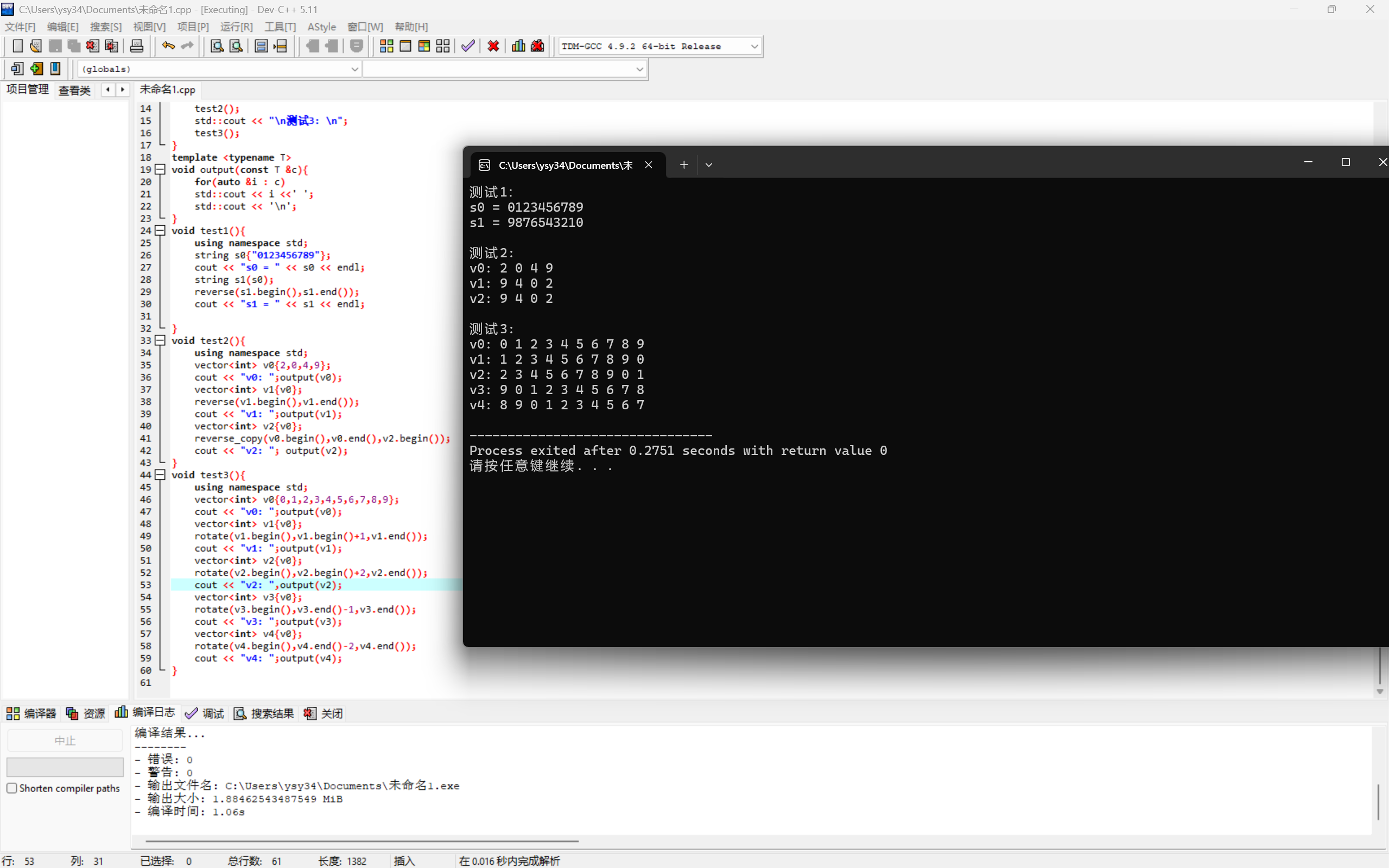
问题1:reverse是原地反转容器中的元素顺序,reverse_copy是将反转后的结果复制到另一个容器中
问题2:rotate通过指定中间点来实现元素的循环位移
rotate(first,middle,last)first指要旋转范围的第一个元素,middle指将成为新序列第一个元素的那个元素,last指旋转范围最后一个元素的下一个位置
任务2
源代码task2.cpp
#include <iostream> #include <vector> #include <algorithm> #include <numeric> #include <iomanip> #include <cstdlib> #include <ctime> template<typename T> void output(const T &c); int generate_random_number(); void test1(); void test2(); int main() { std::srand(std::time(0)); std::cout<<"测试1: \n"; test1(); std::cout << "\n测试2: \n"; test2(); } template <typename T> void output(const T &c) { for(auto &i: c) std::cout << i << ' '; std::cout << '\n'; } int generate_random_number() { return std::rand() % 101; } void test1(){ using namespace std; vector<int> v0(10); generate(v0.begin(), v0.end(), generate_random_number); cout << "v0: "; output(v0); vector<int> v1{v0}; sort(v1.begin(), v1.end()); cout << "v1: "; output(v1); vector<int> v2{v0}; sort(v2.begin()+1, v2.end()-1); cout << "v2: "; output(v2); } void test2(){ using namespace std; vector<int> v0(10); generate(v0.begin(), v0.end(), generate_random_number); cout << "v0: "; output(v0); auto min_iter = min_element(v0.begin(), v0.end()); auto max_iter = max_element(v0.begin(), v0.end()); cout << "最小值: " << *min_iter << endl; cout << "最大值: " << *max_iter << endl; auto ans = minmax_element(v0.begin(), v0.end()); cout << "最小值: " << *(ans.first) << endl; cout << "最大值: " << *(ans.second) << endl; double avg1 = accumulate(v0.begin(), v0.end(), 0.0) / v0.size(); cout << "均值: " << fixed << setprecision(2) << avg1 << endl; sort(v0.begin(), v0.end()); double avg2 = accumulate(v0.begin()+1, v0.end()-1, 0.0) / (v0.size()-2); cout << "去掉最大值、最小值之后,均值: " << avg2 << endl; }
运行结果如下:
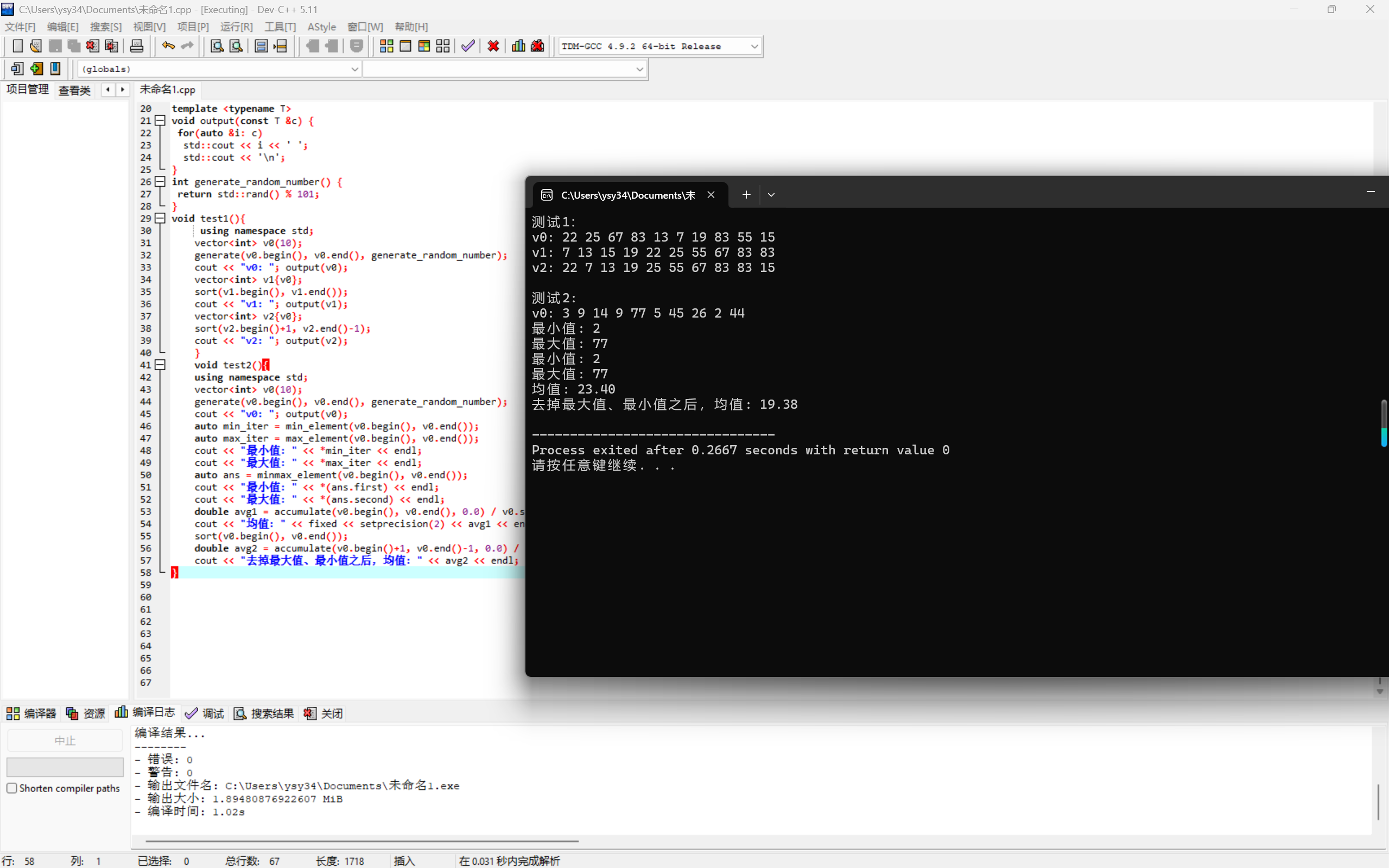
问题1:generate算法的作用是用指定生成器函数生成的值来填充容器的元素
问题2:代码更加简洁,且只需要遍历一次就可以获得最大值和最小值
问题3:效果等同
任务3
task3.cpp
#include <iostream> #include <string> #include <algorithm> #include <cctype> unsigned char func(unsigned char c); void test1(); void test2(); int main() { std::cout << "测试1: 字符串大小写转换\n"; test1(); std::cout << "\n测试2: 字符变换\n"; test2(); } unsigned char func(unsigned char c) { if(c == 'z') return 'a'; if(c == 'Z') return 'A'; if(std::isalpha(c)) return static_cast<unsigned char>(c+1); return c; } void test1() { std::string s1{"Hello World 2049!"}; std::cout << "s1 = " << s1 << '\n'; std::string s2; for(auto c: s1) s2 += std::tolower(c); std::cout << "s2 = " << s2 << '\n'; std::string s3; for(auto c: s1) s3 += std::toupper(c); std::cout << "s3 = " << s3 << '\n'; } void test2() { std::string s1{"I love cosmos!"}; std::cout << "s1 = " << s1 << '\n'; std::string s2(s1.size(), ' '); std::transform(s1.begin(), s1.end(), s2.begin(), func); std::cout << "s2 = " << s2 << '\n'; }
运行结果如下:
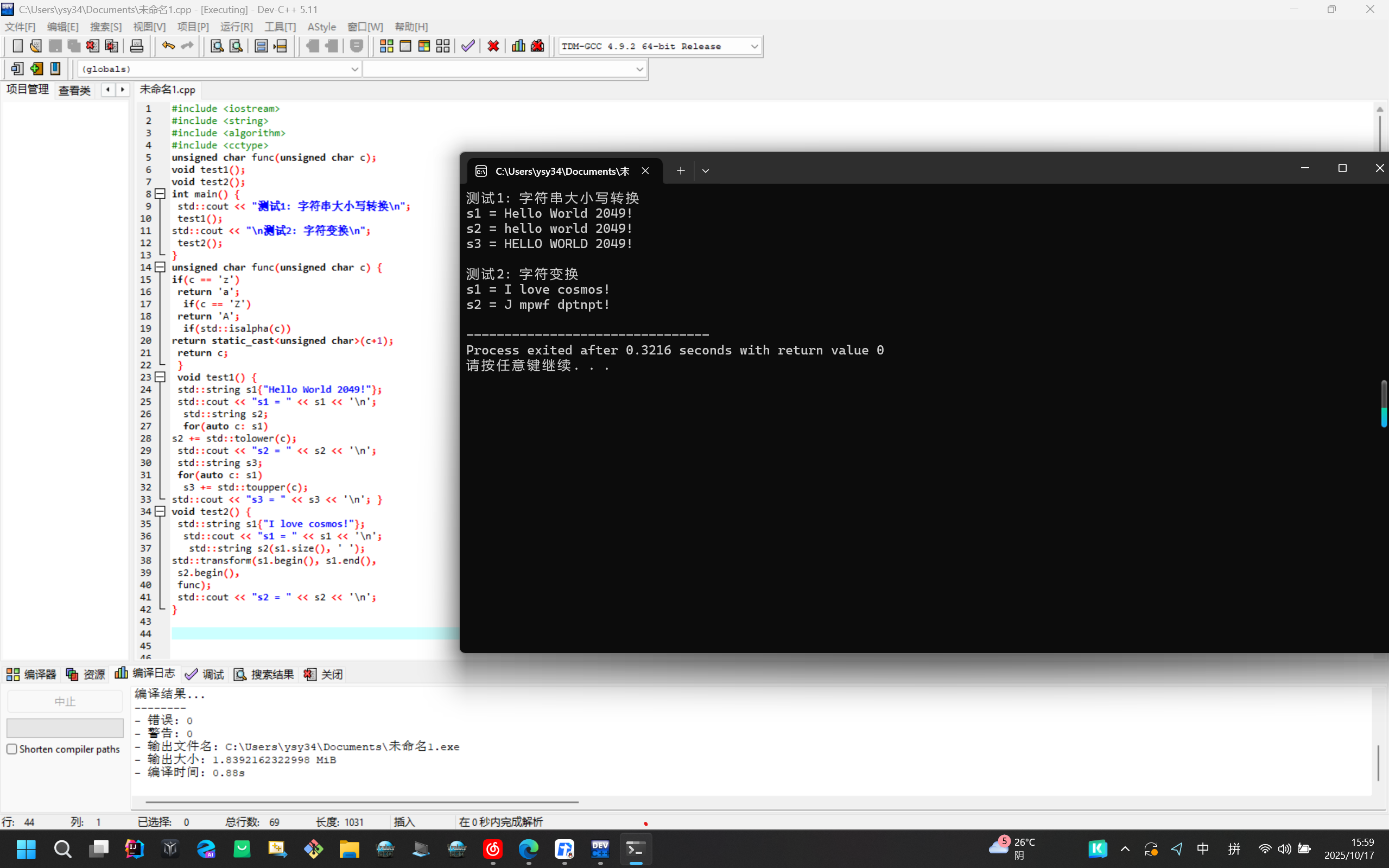
问题1:fun功能是对字母进行循环递增
问题2:tolower功能是将字符转换为小写形式,toupper功能是将字符转换为大写形式
问题3:第一个参数是输入范围的起始位置,第二个参数是输入范围的结束位置,第三个参数是输出位置的起始迭代器,第四个参数是变换函数。使用s2.begin()会保留原始数据,改成s1.begin()会原地修改数据
任务4
task4.cpp
#include <iostream> #include <string> #include <algorithm> #include <cctype> bool is_palindrome(const std::string &s); bool is_palindrome_ignore_case(const std::string &s); int main() { using namespace std; string s; while(cin >> s) { cout << boolalpha << "区分大小写:" << is_palindrome(s) << "\n" << "不区分大小写:" << is_palindrome_ignore_case(s) << "\n\n"; } } bool is_palindrome(const std::string &s) { if (s.empty()) return true; int left = 0; int right = s.length() - 1; while (left < right) { if (s[left] != s[right]) { return false; } left++; right--; } return true; } bool is_palindrome_ignore_case(const std::string &s) { if (s.empty()) return true; int left = 0; int right = s.length() - 1; while (left < right) { if (std::tolower(s[left]) != std::tolower(s[right])) { return false; } left++; right--; } return true; }
运行结果如下:
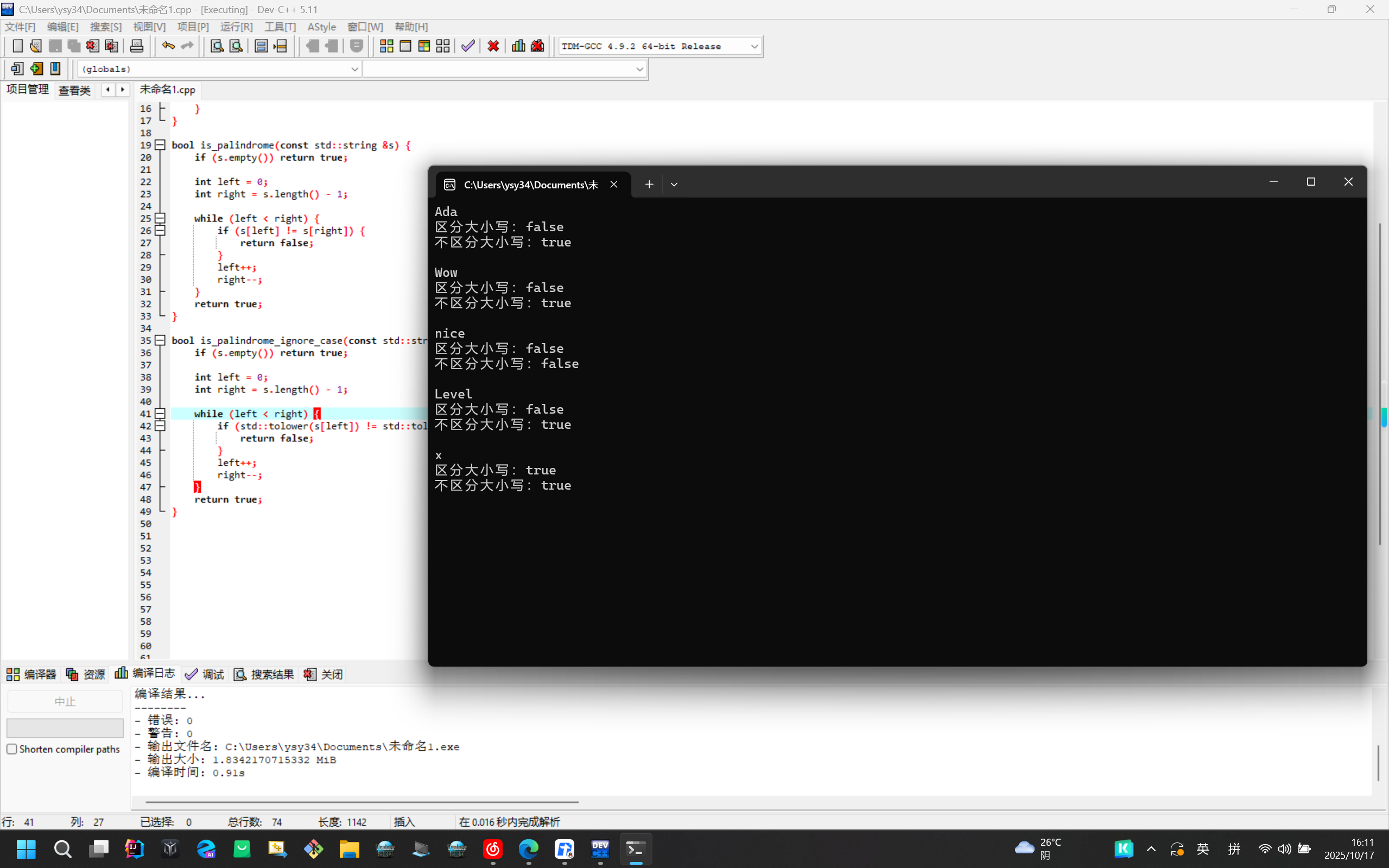
问题1:需要修改main函数
int main() {
using namespace std;
string s;
while(getline(cin, s)) {
if (s.empty()) continue;
cout << boolalpha
<< "输入: \"" << s << "\"\n"
<< "区分大小写:" << is_palindrome(s) << "\n"
<< "不区分大小写:" << is_palindrome_ignore_case(s) << "\n\n";
}
}
任务5
task5.cpp
#include <iostream> #include <string> #include <algorithm> std::string dec2n(int x, int n = 2); int main() { int x; while(std::cin >> x) { std::cout << "十进制: " << x << '\n' << "二进制: " << dec2n(x) << '\n' << "八进制: " << dec2n(x, 8) << '\n' << "十二进制: " << dec2n(x, 12) << '\n' << "十六进制: " << dec2n(x, 16) << '\n' << "三十二进制: " << dec2n(x, 32) << "\n\n"; } } std::string dec2n(int x, int n) { if (x == 0) { return "0"; } if (n < 2 || n > 36) { return "Error: n must be in [2, 36]"; } std::string result; while (x > 0) { int remainder = x % n; if (remainder < 10) { result += '0' + remainder; } else { result += 'A' + (remainder - 10); } x /= n; } std::reverse(result.begin(), result.end()); return result; }
运行结果如下:
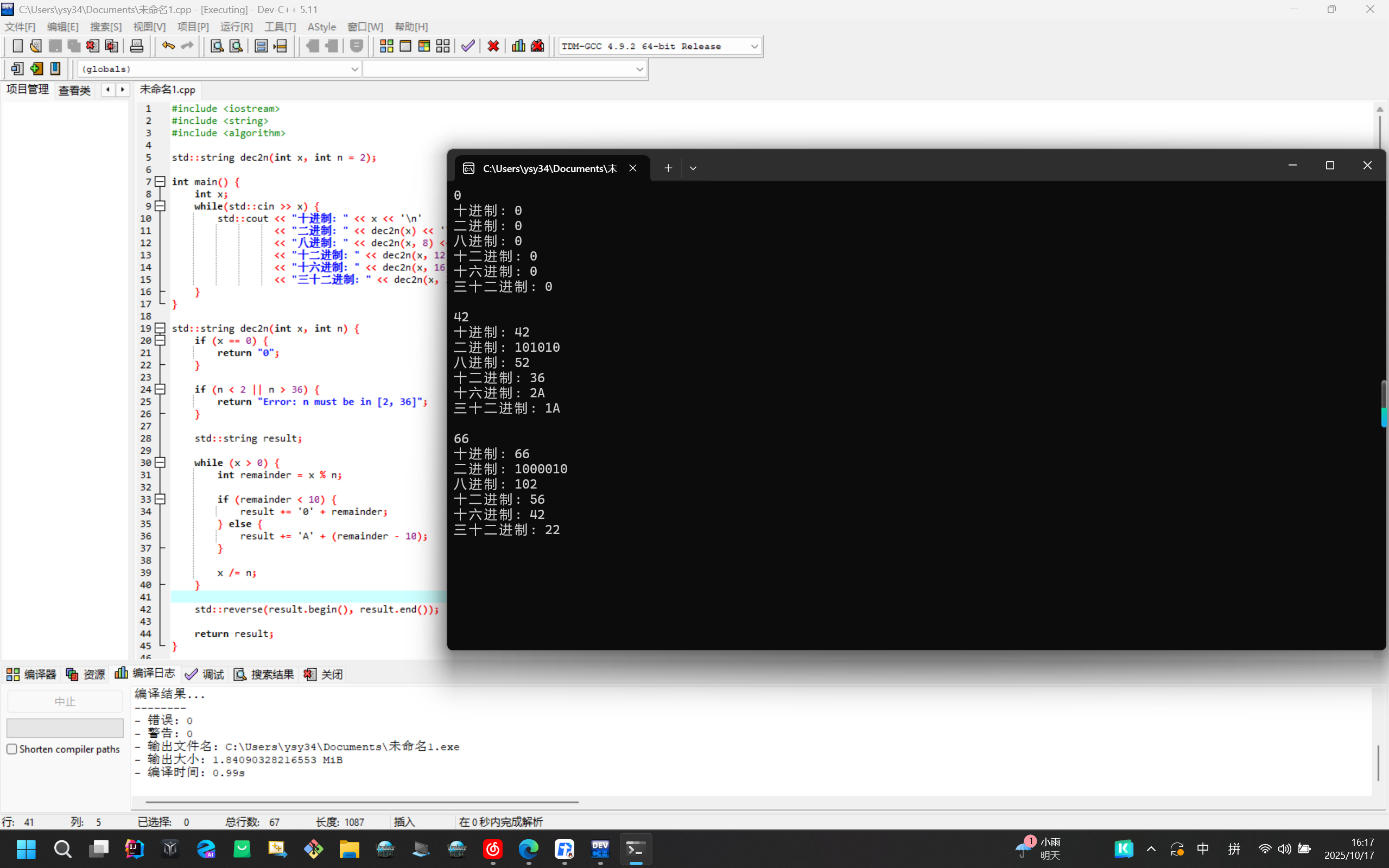
任务6
task6.cpp
#include <iostream> #include <string> int main() { const std::string alphabet = "abcdefghijklmnopqrstuvwxyz"; for (char c : alphabet) { std::cout << c << ' '; } std::cout << std::endl; for (int shift = 1; shift <= 26; shift++) { std::cout << shift; std::string shifted; for (int i = 0; i < 26; i++) { int new_pos = (i + shift) % 26; shifted += alphabet[new_pos]; } for (char c : shifted) { std::cout << c << ' '; } std::cout << std::endl; } return 0; }
运行结果如下:
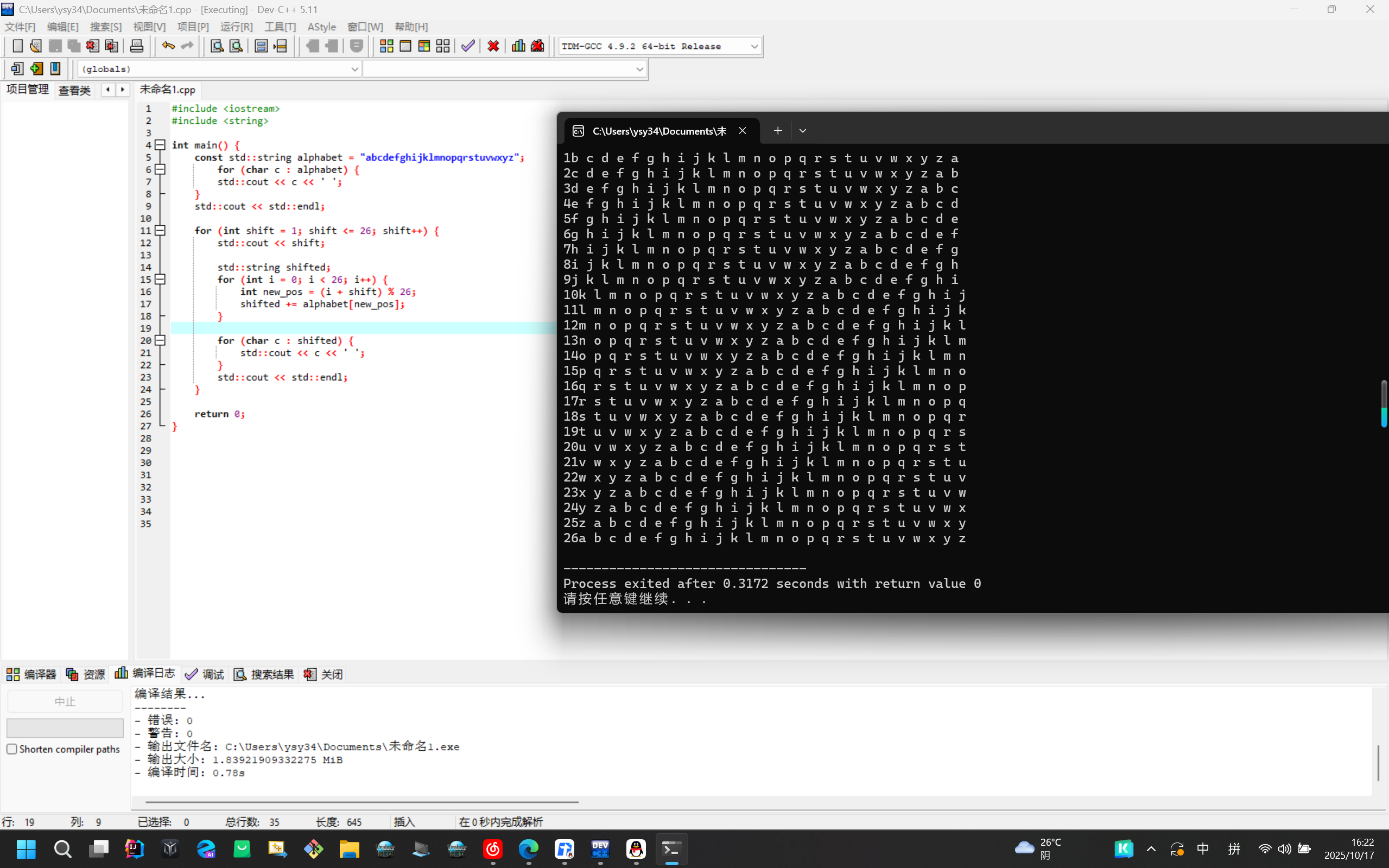
任务7
task7.cpp
#include <iostream> #include <cstdlib> #include <ctime> #include <iomanip> int main() { std::srand(std::time(0)); int correct_count = 0; const int total_questions = 10; std::cout << "小学生算术运算测试\n"; std::cout << "==================\n"; for (int i = 0; i < total_questions; i++) { int num1 = std::rand() % 10 + 1; // [1, 10] int num2 = std::rand() % 10 + 1; // [1, 10] int op = std::rand() % 4; char op_char; int correct_answer; int user_answer; switch (op) { case 0: op_char = '+'; correct_answer = num1 + num2; break; case 1: op_char = '-'; if (num1 < num2) { std::swap(num1, num2); } correct_answer = num1 - num2; break; case 2: op_char = '*'; correct_answer = num1 * num2; break; case 3: op_char = '/'; while (num1 % num2 != 0) { num2 = std::rand() % 10 + 1; } correct_answer = num1 / num2; break; } std::cout << num1 << " " << op_char << " " << num2 << " = "; std::cin >> user_answer; if (user_answer == correct_answer) { correct_count++; } } double accuracy = static_cast<double>(correct_count) / total_questions * 100; std::cout << "\n正确率:" << std::fixed << std::setprecision(2) << accuracy << "%\n"; return 0; }
运行结果如下:
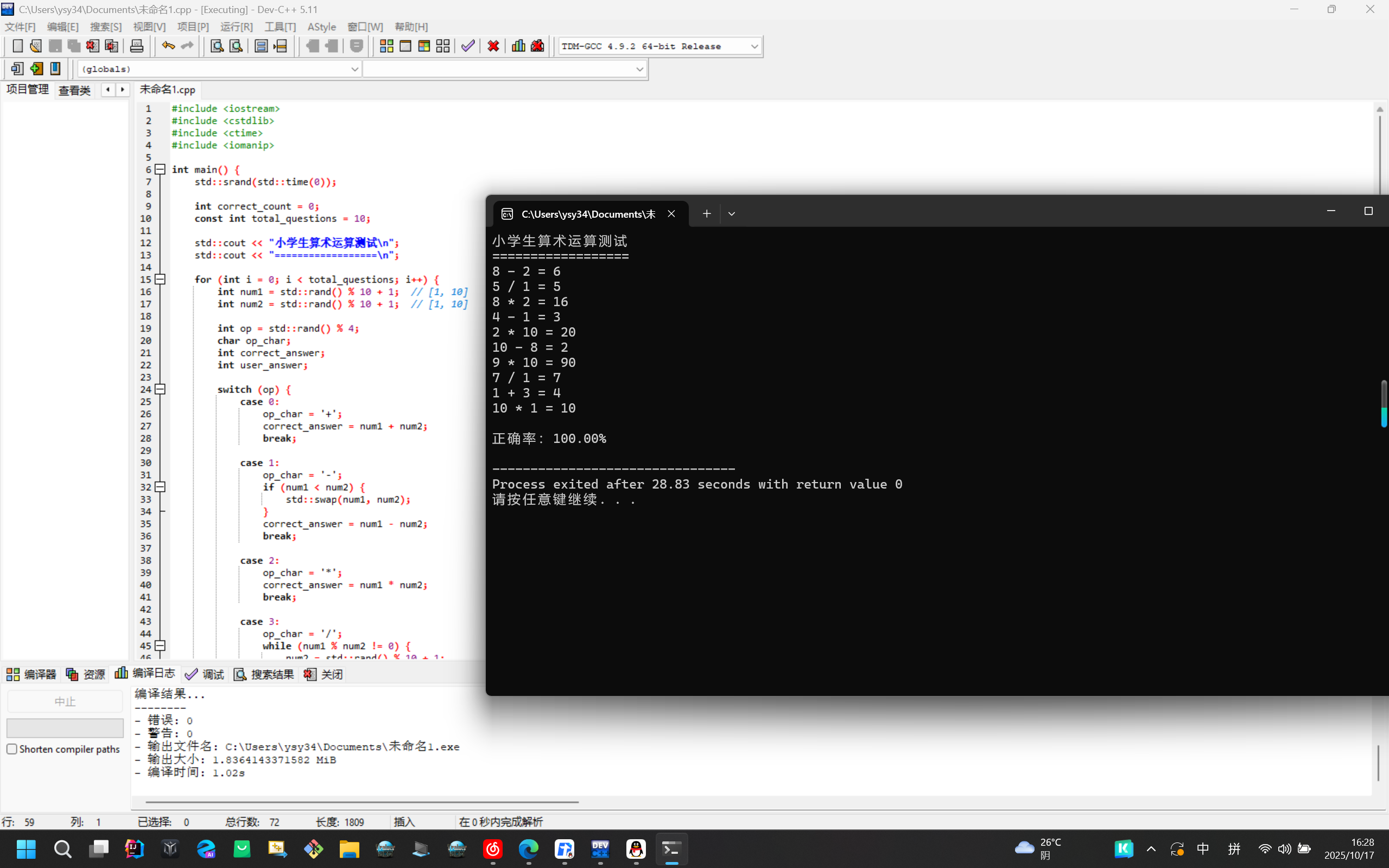




 浙公网安备 33010602011771号
浙公网安备 33010602011771号